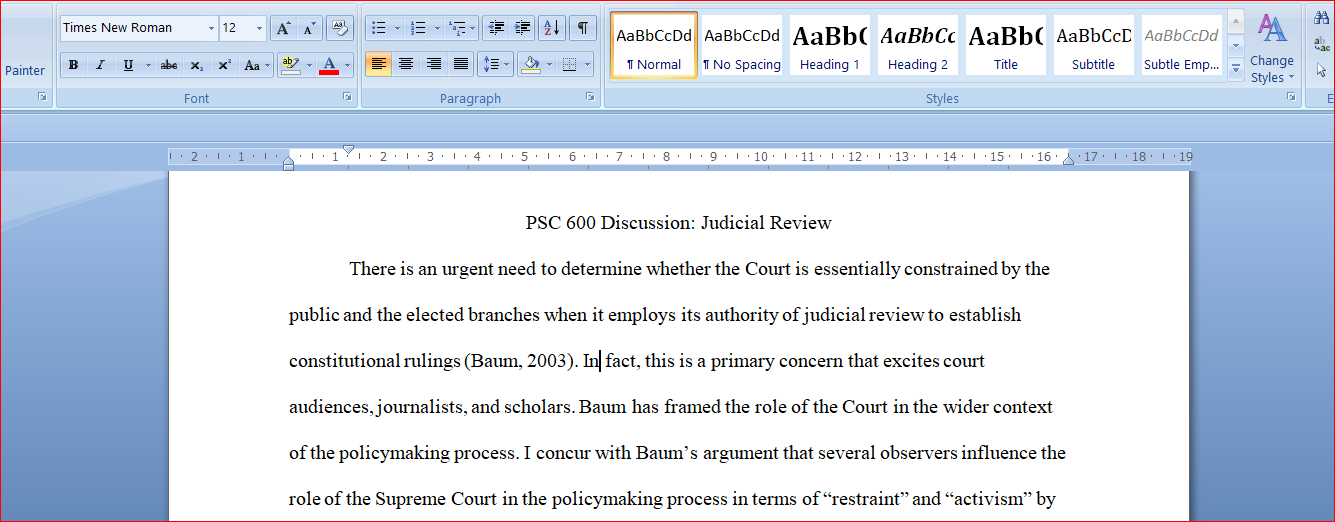The Political Context of Judicial Review
Week 5 Video Lecture: The Political Context of Judicial Review, Part I
In the next two weeks, we will discuss the political context of judicial review with a focus on the following issues: (1) when and why should the Supreme Court intervene in public policy? (2) When the Court intervenes in a policy dispute using its power of judicial review, is it constrained by the preferences of Congress, the President, or the American public? (3) Do Congress and the President sometimes support the active use of judicial review and try to use it to their electoral or
policy advantage? (4) How effective is the Court in policymaking vis-à-vis judicial review and constitutional interpretation? (5) How impactful is the Court in the policy process? Can the Court bring about substantial policy and/or social change?
We will discuss many of these issues this week in the context of two recent and monumental Supreme Court decisions from the past two years, each of which constituted a significant intervention in the policy process: (1) the Supreme Court’s 2012 ruling which upheld the Affordable Care Act, or what many call “Obamacare” (that case is called National Federation of
Independent Business v. Sebelius) and (2) last term’s landmark ruling that struck down the federal Defense of Marriage Act, resulting in the federal government now recognizing same-sex marriages from states where same-sex marriage is legal. These cases provide an interesting comparison in that in the ACA ruling, the Supreme Court exercised restraint and upheld the ACA health care law (with the exception of the Medicaid expansion issue), which in turn left the policy status quo largely in place. However, in the DOMA ruling, the Supreme Court struck down a federal law as unconstitutional, which in turn generated substantial policy implications.
These rulings demonstrate the capacity of Supreme Court power, though they also help us think about the limits of judicial power and degree to which the Court may be constrained from taking a particular course of action.
In addition to these two cases, we will also be reading two articles, one by Lawrence Baum and another by Keith Whittington. Baum’s article lays out the broad contours of the Supreme Court’s role in the American political system. First, note Baum’s use of the term “interventions” in the policy process. By this he means instances in which the Supreme Court decides to hear the case and rule on a policy issue that was passed by Congress and the President or by a state government. While Baum defines interventions as instances where the Court modifies or significantly alters a policy passed by the federal government or a state government, it is important to understand why the Court chooses to uphold laws as well as strike down laws. When the Court decides to hear and rule on a case, it is intervening in the policy process. Of course, the ruling itself determines the outcome of the intervention – whether it decides to invalidate existing policy or uphold the status quo. Note also Baum’s preference for the word “intervention” as opposed to “activism,” which has become a less-than-precise concept due to its use by politicians as a sort of “catch-all” to criticize rulings with which they disagree.
One additional word of clarification is in order. In this class, we have focused on judicial review, of course, which entails constitutional interpretation. In other words, does a state or federal law violate a particular provision of the U.S. Constitution? Roughly half of the Court’s agenda in the contemporary era has been devoted to these types cases where the Court is exercising its power of judicial review. However, the other half consists of cases where the Court engages in statutory
interpretation whereby the Court is not judging the constitutionality of statutes. In many statutory………………………………….
Answer preview for the Political Context of Judicial Review
Words:1221

